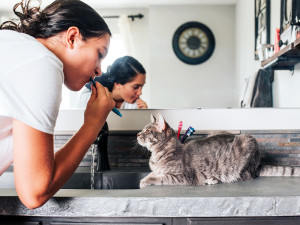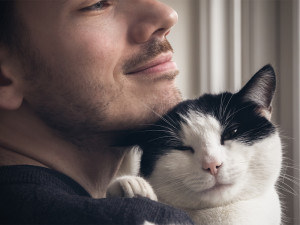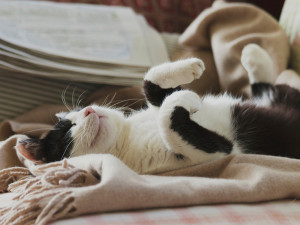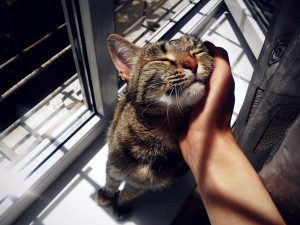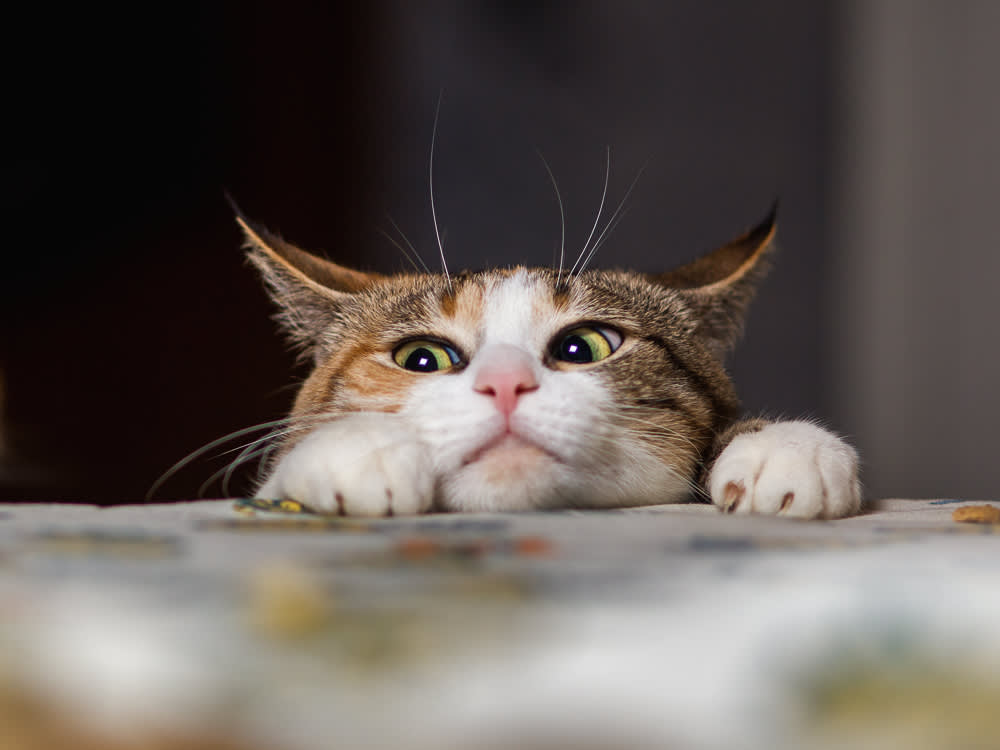
Share Article
Ever wonder why your cat follows you everywhere? Do you constantly have the feeling that you’re being watched? Wake to a furry figure towering over you? Do you have a mini-voyeur outside your shower or a judgmental little supervisor staring you down on every work call? If you do, welcome to some of the many joys of cat parenthood.
Maybe you’ve always wanted a cat and finally adopted one, or you’re an experienced cat parent just now realizing how you’re never alone. Yes, your cat is a stalker, and the call is coming from inside the house. But never fear: It’s just your cat being a cat.

littleKin™ is Kinship’s home just for puppy and kitten parents. Bop over to check out expert advice, new pet tools, and special deals—all curated for your newest family member.
opens in a new tabMain takeaways
Cats can follow you around for a variety of reasons, including curiosity, wanting attention, and anxiety.
Try not to reward unwanted behaviors with attention or interaction.
To help reduce following behavior, keep to a set schedule of feeding, play, and rest so your cat knows what to expect.
Why do cats follow you everywhere?
Understanding why your cat is following you around can help to reduce some of the weirdness of having a pair of eyesopens in a new tab tracking your every movement and potentially help you to take steps to lessen the invasion of privacy. If you are concerned about your cat’s behavior, it is always best to consult with a veterinarian or animal behaviorist. They can help you determine the cause of your cat’s behavior and recommend individualized strategies to address it.
Cats aren’t creeps — well, they sort of are, but not in a nefarious way — they’re simply misunderstood. Cats shadow us for a number of reasons: to get attention, register a complaint about a problem, show their undying affection, or make sure you know they’re hungry. Your cat may be living a cushy life at home, but inside beats the heart and lingering ancestral memory of a hunter, out in the wild sneaking up to pounce on prey, aka dinner. In real life, your cat recognizes you as the main food source, which explains why you’re the lucky recipient of your cat’s stealth attention. And they have no issue sending word that the service at their most frequented restaurant is slower than they’d like.
Ten main reasons your cat keeps following you
1. They’re hungry.
Here’s another note on understanding your hungry cat, who likely follows you around nonstop, rubbing against your legs and talking at you with a determined, high-pitched meow. Cats’ natural dining rhythm is five small meals throughout the day. Most domestic cats are forced to follow our feeding schedules, which are behaviorally and psychologically unnatural for cats.
This is the reason why some cats try to train their humans to wake up earlier to feed them by biting their toes in bed or sitting on top of them and meowing in their faces. They’re frustrated by not having their innate meal patterns met and are not shy about popping up anywhere, anytime to let you know.
2. They want your attention.
If your cat isn’t hungry and is still lurking around or checking up on you constantly, they may just be trying to get your attention. Even the most aloof cats will try to alert you to something they feel is important. This may be as little as a toy stuck under the couch or as big as Hey, there’s something weird happening over here. Because they’re super clever and persistent creatures, cats can resort to multiple creative tricks beyond the classic stalk mode, including:
Pawing at you
Knocking things off tables, couches, or counters
Stealing or playing with objects, including ones you are currently using
Jumping up to be at your level
Inhibited bitesopens in a new tab (typically a nibble, not a full-on bite)
3. They might be sick or in pain.
If your cat shows an increase in attention-seeking behaviors or any changes in their typical behavior, you should take your cat to the veterinarian. Sudden behavior changes can be an indicator of an underlying medical condition. Your cat could be following you around more than usual, seeking reassurance and comfort from pain.
4. They may be stressed or anxious.
Cats like a set routine. Food at food time, play at play time, and naps at all other times. Disruptions to their kitty schedule cause anxietyopens in a new tab. Some anxious cats hide until the stress-y thing goes away, while others seek out their comfort person: you.
5. They are bored.
Even though cats love a good nap, they still have bursts of energy throughout the day (and night, unfortunately). When they feel it’s playtime, you’re in the best position to provide them with entertainment. Cats don’t particularly care that you’re in the middle of a meeting, watching a game, or cooking dinner. They’ll stare you down until you do something fun.
6. They are territorial.
Figuring out cat psychology is quite a task, but it’s possible that your cat feels you need supervision while you’re walking around or just plain existing in their house. After all, you are comparatively rather large, clumsy, and completely unable to groom yourself properly.
7. They are bonded to you.
Following behaviors can indicate a strong human-cat bond. Your cat may see you as their friend, guardian, or ward, and they want to be involved in whatever awesome thing you’re doing — even if it’s going to the bathroom.
8. You've trained them to follow you.
Many behaviors in cats are learned, and we sometimes teach them without realizing it. Cats may realize that they get rewarded with good scritches, treats, or playtime when they stick around you. Why not follow you to the next room and see if something good happens?
9. They are worried about you.
Many cat parents swear their cats refuse to leave them when they’re upset or sick. Your cat may know when you need a little extra comfort and stick around more to make sure you’re OK. Nothing says comfort when you’re feeling down like lying in bed with a purring fuzzball curled up next to you.
10. They are curious creatures.
Cats are naturally inquisitive and want to know what’s going on around them. If you’re moving, there’s a chance you may do something fun or exciting. After all, sometimes food falls off the counter when you’re in the kitchen, or a toy gets tossed if you’re walking down the hallway.
Will following behavior change as a cat ages?
Yes — a kitten’s behavior will definitely differ from a senior cat. Kittens are brand new to the world, and everything is exciting to them. They’re still figuring out which activities require their attention and which don’t merit getting out of bed. Older cats familiar with your routine likely know the difference between you getting up to go to the bathroom and you preparing a meal that they could maybe be involved with.
How do I stop my cat from stalking me?
The hard part with attention-seeking behaviors is that any interaction we have with our cats — positive (like trying to reassure them with petting) or negative (such as reprimanding) — will only reinforce the behavior, as they are both seen as attention. Even a glance in your cat’s direction will reinforce and keep the stalking coming. So, what to do?
Provide appropriate outlets for that behavior
Give your cat enrichment alternatives like puzzle feedersopens in a new tab, toysopens in a new tab, or catnipopens in a new tab. A bored cat will follow you around looking for something to do, so provide entertainment to keep them occupied and out of your hair.
Walk away.
You are the source of your cat’s attention. Go about your business and ignore your cat’s attention-seeking behavior, then reward them when they’re calmer and settled down. This can be challenging because cats are great at putting themselves in your way or finding something irritating to do.
Make sure you have enough scratching posts.
Environmental enrichment should be a combination of vertical (cat treesopens in a new tab) and horizontal posts (cat hammocksopens in a new tab), crinkly blankets, and places for your cat to hide. If your cat can observe you from a good lookout, they’re less likely to be attached to your hip.
Check your cat’s litter boxes.
Cats are fastidious and don’t want to go in an already-soiled litter box. It’s best to stay on top of litter box upkeepopens in a new tab and make sure you have good litter box options so you don’t end up cleaning up pee elsewhere. Your cat won’t feel a bit of guilt either — after all, they tried to tell you.
Check your cat’s water.
Make sure your cat’s basic needs are all covered before you go looking for problems. Maybe the water spilled, is empty, or just isn’t as fresh as your cat would like.
Schedule daily play time.
At least once a day, book some fun time with your cat with interactive toysopens in a new tab and cat wands. Embrace your inner cat parent. Cats are addicted to habit and feel more secure and confident with a consistent routine. To help your cat decrease attention-seeking behaviors, combine the security of a schedule with positive reinforcement training and playtime.
Bottom line
It’s a common myth that cats are independent, standoffish characters — any cat person will call nonsense on that claim. In fact, cats think of us as part of their family group, which is why they rub around our legs, greet us when we come back home, lick us, and stay by our side when we’re having a bad day.
So, yes, your cat is a stalker, but the most charming kind. Relax and enjoy your little creeper (but keep the food coming, just to be safe).
FAQs
Is it normal for cats to follow their parents everywhere?
It’s fairly common for cats to follow their humans around, because they’re hungry, want your attention, or might not feel well. Or they could be imprinting on youopens in a new tab.
Is following behavior exclusive to indoor cats?
Indoor cats will likely follow you more simply by virtue of not roaming around outside! Generally, being outdoors gives a cat more control over their actions.
References
Ines, Mauro et al. “My Cat and Me-A Study of Cat Owner Perceptions of Their Bond and Relationship.” Animals : an open access journal from MDPI vol. 11,6 1601. 29 May. 2021, doi:10.3390/ani11061601opens in a new tab
Elzerman, Ashley L et al. “Conflict and affiliative behavior frequency between cats in multi-cat households: a survey-based study.” Journal of feline medicine and surgery vol. 22,8 (2020): 705-717. doi:10.1177/1098612X19877988opens in a new tab

Dr. Bartley Harrison, DVM
Dr. Bartley Harrison, DVM is a small animal veterinarian based in North Carolina who has practiced emergency medicine since graduating from the Texas A&M College of Veterinary Medicine. His primary interest areas include pain management, cardiology, and the treatment of shock.
He is a member of the Veterinary Emergency and Critical Care Society, American Veterinary Medical Association, and American Medical Writers Association. In addition to his clinical work, he writes pet health articles to help provide accurate information for both new and experienced pet parents. When he’s not working, he enjoys cooking, traveling, reading, and going on adventures with his dog.

Ruby Leslie, CPDT-FF
Ruby Leslie is a certified positive reinforcement force-free trainer and Dogly Training Advocate. She has consulted, worked with, and volunteered at animal shelters across the world including China, Thailand, the UK, and Canada where she now resides with her cats.
Related articles
![cat snuggling man]() opens in a new tab
opens in a new tabWhat’s Your Cat’s Love Language?
Five surprising ways cats show affection (and how you can show it back), according to a cat behaviorist.
![cat staring at person on table]() opens in a new tab
opens in a new tabWhy Does My Cat Stare at Me?
...Is it something you said?
![]() opens in a new tab
opens in a new tabHow to Read Your Cat’s Poker Face
A guide to their not-so-secret tells.
![An angry and hissing Siamese kitten standing on top of a laptop computer in the living room]() opens in a new tab
opens in a new tabYou Don’t Have to Live Like This—You Can Get a Trainer For Your Cat
Tips to help you find a legit behaviorist (according to a veterinary behaviorist).
![Black and White cat with its eyes closed laying on its back on a scarf]() opens in a new tab
opens in a new tabIs My Cat Happy?
In this excerpt from her new book, Purr: The Science of Making Your Cat Happy, animal behaviorist Zazie Todd shares science-backed insights into our cats’ moods.
![Cat being happily pet in the sunshine of a window]() opens in a new tab
opens in a new tabHow to Pet a Cat (Without a Scratch)
There is a right and wrong way.
